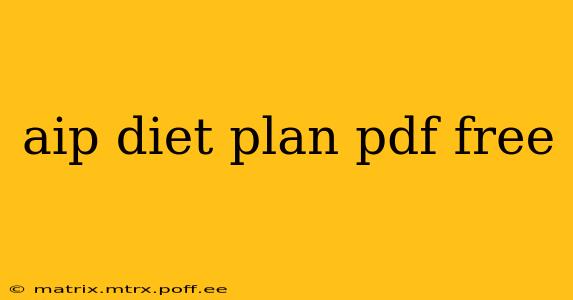AIP Diet Plan: A Comprehensive Guide to the Autoimmune Protocol
The Autoimmune Protocol (AIP) diet is a restrictive elimination diet designed to help identify and eliminate food sensitivities that may be contributing to autoimmune diseases. While there isn't a single, universally accepted "AIP diet plan PDF free" readily available, this guide provides a comprehensive overview to help you understand and implement the AIP diet effectively. Remember, consulting with a healthcare professional or registered dietitian before starting any restrictive diet, especially one as stringent as the AIP, is crucial.
What is the AIP Diet?
The AIP diet is a temporary elimination diet that removes foods commonly associated with inflammation. The goal isn't just weight loss, but rather to identify potential food triggers that exacerbate autoimmune symptoms. Once these triggers are identified (often through a process of elimination and reintroduction), individuals can carefully reintroduce foods to determine their personal tolerance levels.
Foods to Eliminate on the AIP Diet:
The AIP diet is highly restrictive. Foods to avoid include:
- Nightshades: Tomatoes, potatoes (white, red, and sweet potatoes), eggplant, peppers (bell peppers, chili peppers, etc.), goji berries, and paprika.
- Processed Foods: This includes packaged foods with additives, preservatives, and artificial ingredients.
- Legumes: Beans, lentils, peas, peanuts (although technically a legume, peanuts are also commonly included in the elimination phase due to their allergenic potential).
- Grains: Wheat, corn, rice, oats, barley, rye, and other grains.
- Dairy: Milk, cheese, yogurt, and other dairy products.
- Eggs: Chicken and other bird eggs are typically removed.
- Nuts and Seeds: Though some seeds are reintroduced later, most nuts and seeds are eliminated initially.
- Seafood (some): Shellfish, particularly, are often excluded due to common allergic reactions. Certain types of fish are generally allowed, but it's best to consult a guide.
- Alcohol: Alcoholic beverages should be avoided.
- Added Sugars: Refined sugars, honey, and other added sweeteners.
- Coffee and Tea: Both are usually excluded, even decaf.
Foods Allowed on the AIP Diet:
The AIP diet, while restrictive, still offers a range of nutritious food options:
- Meat: Grass-fed beef, lamb, chicken (sometimes limited to bone-in, organic options), and turkey are generally allowed.
- Fish: Many types of fish are allowed (check for any potential allergens, and always check your local fish stock guidance).
- Fruits and Vegetables (except Nightshades): Most fruits and vegetables are included, offering a good source of vitamins and minerals.
- Healthy Fats: Avocado, olive oil, coconut oil, and other healthy fats are essential.
- Herbal Teas: Certain herbal teas may be acceptable, depending on the individual's sensitivities. Check with your doctor or registered dietitian before incorporating any new teas.
Frequently Asked Questions (FAQs)
How long should I follow the AIP diet?
The duration of the AIP diet varies greatly depending on individual needs and responses. Some people follow it for several weeks, while others follow it for several months. Close monitoring of symptoms with the guidance of a healthcare professional is essential.
Can I lose weight on the AIP diet?
Weight loss is a possible side effect, but it's not the primary goal of the AIP diet. The focus is on identifying and eliminating food sensitivities that may be contributing to autoimmune issues. The restrictive nature of the diet often leads to calorie reduction, which can contribute to weight loss in some individuals.
What are the potential side effects of the AIP diet?
Some individuals may experience nutrient deficiencies if the diet isn't properly planned. Constipation, fatigue, and headaches are also possible. A registered dietitian can help ensure adequate nutrient intake.
Can I reintroduce foods after the initial elimination phase?
Yes, the reintroduction phase is a crucial part of the AIP diet. Foods are gradually reintroduced one at a time to determine which foods trigger symptoms. This process helps pinpoint specific food sensitivities and allows for personalized dietary adjustments.
Are there any resources available to help me plan my AIP meals?
Numerous books, websites, and blogs provide recipes and guidance for the AIP diet. However, it’s important to carefully vet the information and ensure it aligns with your specific health needs. Always consult with a healthcare professional before making significant dietary changes.
Disclaimer: This information is for educational purposes only and should not be considered medical advice. Always consult with a healthcare professional or registered dietitian before starting any new diet, especially a restrictive diet like the AIP. They can help you create a personalized plan that meets your individual needs and ensures your overall health.
